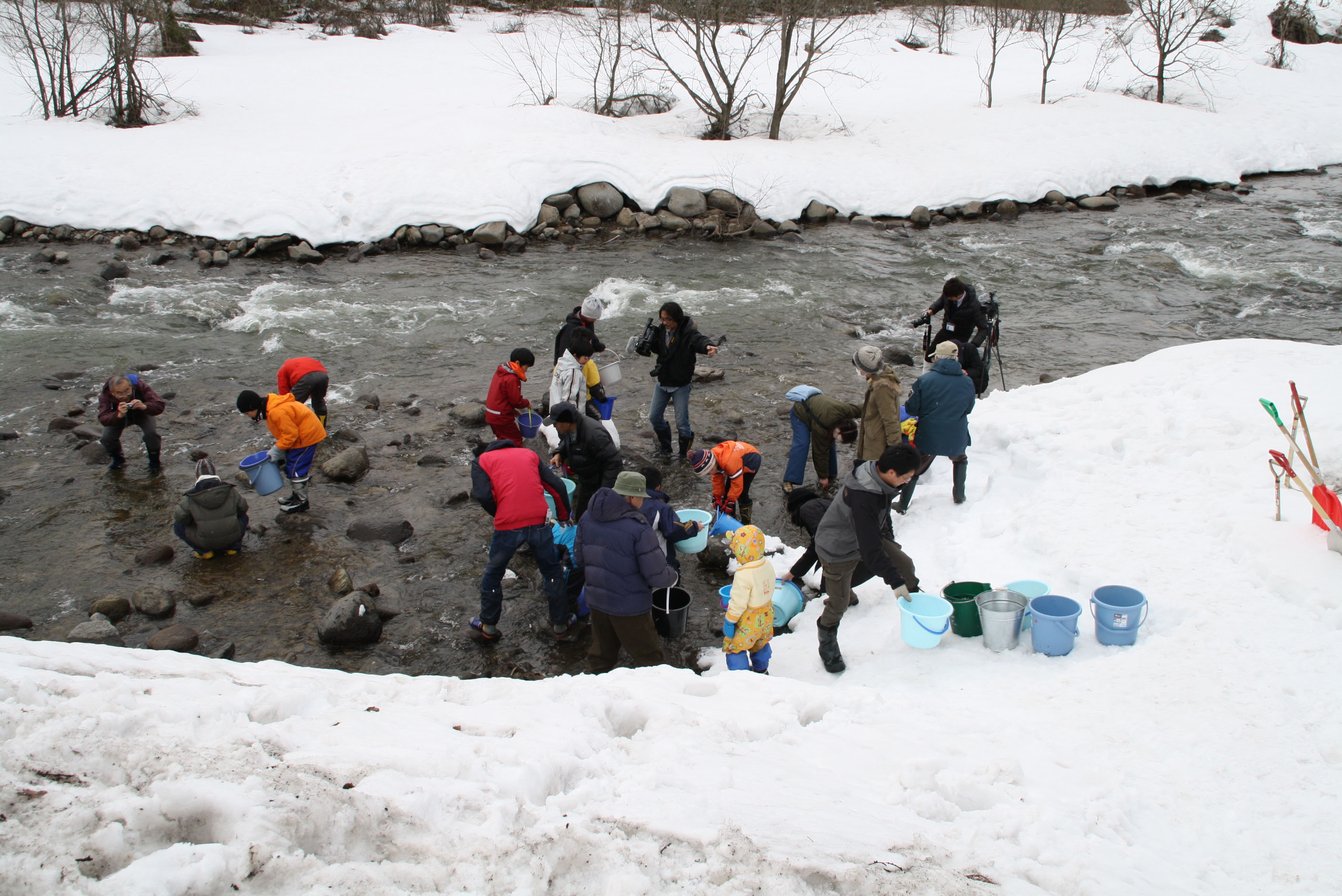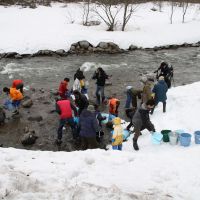The Shinano, at 374 km the country's longest river, empties into the Sea of Japan at Niigata City. Salmon still migrate back from the open ocean to this river of their birth to breed and die, but a few decades ago they would arrive to spawn not only in the main river but also in its many tributaries, way inland.
The Torii River is one such tributary — one which flows just meters from my study window up here in the northern Nagano Prefecture hills. The Torii is a fast, usually clear, and very cold mountain stream that rushes down from 2,053-meter Mount Kurohime and its slightly lower neighbor, Mount Togakushi, to join the Chikuma River — which flows into the Shinano.
Since 1982, the Torii has been a part of my life. From my study desk I look over my right shoulder to see it, and even with the windows closed I can hear it. When the weather's warm enough, I sleep with my bedroom window open so that I can be lulled into the land of Nod by the cool rush of the mountain water and the gentle breezes it brings.
When it raged and flooded some years ago, and the authorities began to cut down all the riparian trees and begin the usual work of destroying the river with concrete, I made a hell of a fuss, brought in experts, and actually got the government to change the construction plans.
So, instead of concrete for the banks, boulders were used — and the river's stocks of small fish such as char and miller's thumb recovered. Consequently, the river is fine and healthy right here, but various problems downstream — dams, shallow water in summer that gets too warm, pollution and the ubiquitous sterile concrete — make it hard for salmon to come back here.
Despite this, the Niigata Mizube no Kai (Niigata Waterside Association), under the leadership of river expert and former professor Dr. Takashi Okuma, things are gradually improving. On March 24 this year, it obtained 20,000 salmon fry from the Mochida Hatchery in Kijimadaira, Nagano Prefecture, and released them into the Torii River just below my study window.
These salmon, which glory in the Latin name Oncorhynchus masou, are commonly called masu or cherry salmon, and the species used to be common in the western Pacific from Kamchatka to Taiwan. After hatching, the fish spend one to three years in rivers, then two to three-and-a-half years in the sea — where they can reach 50-60 cm in length and attain a weight of 2 to 2½ kg before returning to their hatching site to spawn — if they can make it back, that is.
Well into living memory, Japan had rich salmon-spawning rivers all the way from northern Kyushu north to Hokkaido. In the summer, Kyushu's rivers would generally be too warm for young salmonids (including char and trout) to survive had their heat absorbed from the sun not been offset by clear, cold, mineral-rich underground spring waters from the mountains that seeped into them through their banks. As well, those banks, shaded with willows and other trees and plants, gave the little fish a chance to survive until the main river cooled down. Concrete banks, of course, put an end to this.
I don't want to sound like a broken record, but 98 percent of Japan's once-rich rivers have been dammed and otherwise ruined with concrete, especially since the 1964 Tokyo Olympics furthered the unholy alliance between politicians, high-ranking bureaucrats and the construction industry.
The former abundance of wild and native salmon in Japan probably explains why it is to this day such a popular feature of the nation's diet — even though most of it is now imported, and farmed. Interestingly, too, even though raw salmon is a sushi-shop staple, traditionally the Japanese did not eat it raw due to the possible occurrence of nematode worm parasites in the flesh.
In contrast, the Ainu did eat salmon raw — but only after it had been frozen, which kills the parasites. The same goes for the Canadian and Greenland Inuit with their salmon-size Arctic char. When I was 18, I remember being scolded by an Inuit "auntie," who told me to "hurry up and eat your fish before it goes raw !"
Now, with modern refrigeration bringing chilled salmon by air all the way from places such as Norway and Tasmania, eating farmed fish raw seems fairly safe, though there are cases of people being hospitalized with terrible stomach-cramp attacks caused by the Anasakiasis parasite which is also sometimes present in very fresh raw squid and mackerel. Not that I want to put you off sushi, which is one of my very favorite foods!
March 24 was a raw, cold day here in Kurohime, but local children gathered with little buckets to get the silvery salmon fry scooped in, and then to carefully carry the buckets down a snow bank to release the fish into the river. Not a single bucket was spilled. However, as the Torii River was several degrees colder than the water in the aerated tank in which the fry were brought, snow was put in the tanks to cool the water and avoid causing shock to the little creatures. After all, how would you like it if you were scooped out of your comfortable, safe hatchery pond and dumped into icy-cold rushing water filled with rocks?
It was good to see how these children, some very small, took such care with the little salmon, and I really hope that some of those fish will return as spawning adults. There is, though, still a lot of river-restoration work needed downstream — and those concrete-crazy politicians, bureaucrats and construction bosses who think it's easier to import salmon than respect nature in Japan are still around.
But imagine, if hundreds of rivers and thousands of the country's streams had wild fish in them, what it would mean for the future happiness and pleasure of not only resident Japanese, but also visitors here !
I would love to get up one morning, go to my study, and see children shouting and laughing as they splashed after salmon in the river below — the sacred gateway to our snowy mountains.




















With your current subscription plan you can comment on stories. However, before writing your first comment, please create a display name in the Profile section of your subscriber account page.